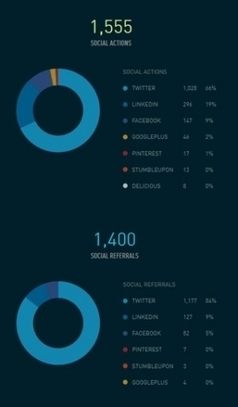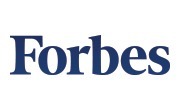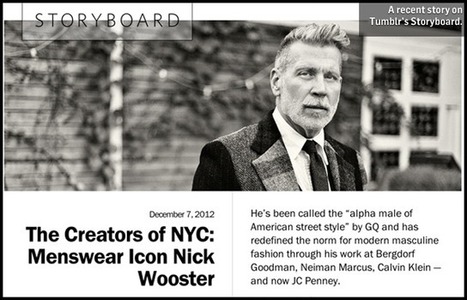 Your new post is loading...
 Your new post is loading...
Articles in a series on Mashable.com called “What’s Inside” looked for all the world like the hundreds of other articles on the digital media site. But journalistically, they were something very different.
The articles, about technology topics in a wide variety of products, including modems and theHubble Space Telescope, were paid for by Snapdragon, a brand of processor chip made by Qualcomm, and the sponsor of the series. Most were even written by Mashable editorial employees.
An article on Google Glass technology was shared almost 2,000 times on social media, indicating that readers may not have cared, or known, if it was journalism or sponsored content, although the series was identified as such. Advertisers and publishers have many names for this new form of marketing — including branded content, sponsored content and native advertising. Regardless of the name, the strategy of having advertisers sponsor or create content that looks like traditional editorial content has become increasingly common as publishers try to create more sources of revenue....
...It’s typically the work of a highly compensated ad agency. But it’s possible that the experiments of a site dedicated to fake news finds itself on the leading edge of a business model that changes the finance model of real journalism. The buzz is whether brand-sponsored content is ruining publishing. But what if publishers could take control of the trend? Creative Partnerships: the Secret Sauce of Sponsored Content? Onion Labs was born barely over a year ago, out of necessity rather than planning. Microsoft was planning an ad buy to coincide with the release of its IE9 browser; the company deemed it “important to get The Onion’s voice and sensibility in their ads,” says Grant Jones, The Onion’s former advertising director and now the VP in charge of Onion Labs....
Brand newsrooms are supposedly the next step in the ad agency’s evolutionary process. The rallying cry is for brands and their agencies to adopt a newsroom-style operation in response to modern media habits. But the reality is that your marketing team and ad agency are not in the business of creating news. This won’t work. Here are four reasons why. Brands are not in the content business. Neither are ad agencies, PR firms or digital shops. More importantly, they are not in the audience development business. That is what newsrooms are about — creating audiences that can be monetized. Everything about news organizations, from culture to employee compensation, is built around moving the audience needle. If you’re building a brand newsroom to enable real-time content production instead of enabling audience development across all your owned media properties, you’re looking through the wrong end of the telescope....
... As marketers, we often get caught up in defining our unique value proposition, distilling it into an elevator pitch, and shouting it in as many ways as we can to a target audience. The problem is that when people are targeted, they take evasive action. And besides, most people really don’t care what you’re trying to sell or why it’s so much better than everything else out there. They just need to like you. Here, I’ll offer tips on how you can create and use branded content to convey the personality of your company — the people who work there; the ideas you live by; the sense of fun and vitality you bring to work; your core values. In addition, I’ll share some examples of how companies, from giants like IBM to much smaller companies (like my own) have used culture-related brand content to compete successfully in the market....
I was recently asked a provocative question: “What experiences or insights have shaped your views on brand and reputation management in today’s business environment?” This is a great question and the more I thought about it, the clearer the answer(s) became. 1. The first insight reflects the The Changing Role of Influence. There is a great quote by Gary Hamel, who says “Influence is like water. Always flowing somewhere.” This is very true in today's business environment as new sources of influence are forming around our companies and industries at an extremely rapid pace....
I had a wonderful time presenting to the attendees of CMI’s recent webinar, Brandscaping and the New Content Marketers. (For those of you who attended, I’m sorry about my cellular connection… I know it made it difficult in those first five minutes.) The webinar generated 55 questions from our intrigued, interested, and extremely intelligent audience. We only got to four or five of those questions in the time allotted, so I offered to answer 11 of the questions that we were not addressed....
Former Businesweek reporter Steve Wildstrom has worked as a “corporate reporter” for Nvidia and Cisco, Giselle Abramovich writes. Those are people “who work inside the company and produce media like blog posts, videos, webinars and more,” she writes. The twist is this path isn’t exactly like public relations. Brands are realizing, to a degree, that if they truly want to be publishers they can’t just have people churning out corporate boilerplate. They’re loosening the reins a bit in a bid to attract actual reporters. Wildstrom says he was worried how his colleagues would react, but “Cisco’s editorial policy is to forbid its writers from covering the company or its competitors,” Abramovich notes. Wildstrom, who covers tech, tells her he steers clear of pieces he can’t report honestly: “That’s how I have chosen to handle it. If I can’t be honest, I won’t write it,” he says....
A form of advertising that is so tightly interwoven within the site it’s being promoted on that customers can’t tell that it’s advertising. Pop quiz: Can you spot the native advertising on BuzzFeed’s homepage? If you answered “all of it,” you’d be exactly right. The entire front page, seemingly devoted to Instagrammers you should be following, actually is a huge advertisement for Samsung cameras. Surprised? Shocked? Amused? Betrayed? All of these emotions are felt by viewers when they realize they’ve been fed advertising in what they thought was an article purely devoted to entertainment or getting more out of a photography hobby. Native ads don’t yet have a clear definition, but at their simplest, they are a form of advertising that is so tightly interwoven within the site it’s being promoted on that customers can’t tell that it’s advertising. Different technologies have tried to paint native ads under names like sponsored listings, promoted posts, or online advertorials, but there are some definite differences....
...The media loves to attach labels to trends. When one catches on, the rush begins. Native advertising (the buzzword of choice right now), social advertising, content marketing and sponsor curation all revolve around the notion of brands as publishers. Everyone’s jockeying for position, FORBES included. Marketers want a bigger voice. The media business needs revenue. The digital world demands change. So, what’s required for this new form of marketing — and for journalism to continue to flourish? Ah, here’s where the fun begins. Buzzfeed talks about viral content. The Huffington Post is into “aligning content and paid advertising strategies.”The Atlantic uses “Sponsor Content Presented By (pick the advertiser). Gawker’s done something similar (it’s actually now talking about a commerce play). As for us, I often talk about brand journalism. BrandVoice is based on the philosophical belief that marketers, with deep understanding of their industries, can offer smart insights, too. In most traditional media companies, that’s a tough sell. Journalists can barely swallow the advertorial — it must be placed in the print or digital equivalent of Siberia. The fact is is, with the click of a mouse or the touch of a screen, the audience can check a marketer’s veracity as easily as it can a journalist’s....
Your content plan doesn’t stop at keyword research. Without context, they’re just words that only provide the first step.
Customers own the story of the brand now. What brands say is far less important than what brands actually do to serve the well being of the faithful. Whereas before, the brand conversation was based on delivery and interruption, successful brand conversations are now participatory in ever more technology driven channels. Storytelling is at the very heart of how we humans share and connect what we value about our heritage, our communities and ourselves. Brand storytelling is about connecting the outer value the brand provides to the inner values of the customer. There must be a deep affinity between the two or the relationship is just a transaction. The foundation for this affinity is built on the shared stories between brands to consumers, customers to brands, and consumers to consumers. Like all relationships, there has to be chemistry. Brands have it or they don’t. How well these collective stories line up with the experience customers have is what creates “insistence without substitutes” in the minds of customers....
Via massimo facchinetti, Jesse Soininen
Marketers often THINK they know exactly what their communities want, but soon find that their content strategy actually prompts users to click unlike or unfollow.
It is not always blatantly obvious why this happens, however a recent study by eMarketer.com has shed some light on the reasons why social media users decide to disconnect from a brand. Let’s take a closer look at the top 5 reasons why users choose to cut ties with brands on social media channels.
My friend Geoff Livingston wrote a piece recently about the term 'Content Marketing,' a term that makes me bristle, the moment I hear it. ...To me there is a very contrary definition to Content Marketing. To me it is the concept that traditional marketers can take traditional and contrived messages and cram them into new communications channels such as Facebook. Content Marketing is about message mongering and not about conversations. Listening is not involved unless you consider count “like” clicks as a form of engagement. It isn’t that I think Content Marketing is evil, as a purist might call it. Instead, I think it is lame and ineffective as a strategy. In social media, your audiences an make you smarter. It can help you bring better products to market faster. It can improve your service response time. It can reduce your time to market and your costs of traditional marketing expenses.... [Nice counterpoint to the content-is-king argument ~ Jeff]
|
How many banks can you think of that put so much faith in the power of brand content that they began producing award-winning television and video shows on a daily basis? No matter how hard you try, it’s likely you’ll only come up with one: Jyske (pronounced You-ska) Bank. Jyske Bank has created one of the most high-tech, in-house television production studios in Denmark. In fact, the company refers to itself as both a bank and a media company.Jyskebank.tv produces amazing financial programming, as well as compelling stories that the bank believes are relevant to its core audience of younger consumers and small enterprises. Jyske’s brand content program is made up of two key values: Remaining true to the organization’s guiding vision, which it calls “Our Foundations“Telling good stories...
Inbound marketing – or combining different online marketing processes such as SEO, content marketing, social media and conversions – has been one of the most effective ways to hit a site’s various business goals in one go, like driving more specifically targeted traffic, improving revenue and/or building a stronger brand mind share. Aside from involving practices that is measurable, utilizing inbound marketing as an approach to reach a business’ target audience (without disrupting their online activities) has proven itself to be very effective in terms of scaling and growing businesses in a shorter span of time. Some of the most known advantages of implementing these practices as a whole are: -Processes involved are cost-efficient and can be implemented in-house. -It works on almost any size of site/business and on almost any industry. -Can help cumulatively achieve business goals (like constantly generating traffic, leads, conversions), through all the past and current efforts done to improve the brand/site. There are so many tactics that you can choose inside the inbound marketing realm that can really help your business grow. Although, in this post, I’ve chosen to highlight a few strategies which I believe can really grow both traffic and conversions when implemented continuously....
Content and commerce have always had a symbiotic relationship that many traditional content providers tried to separate. The wall between editorial and business, otherwise known as the separation of church and state, is and always has contained back doors and windows in which compromises are made. The slow adoption of all that the digital revolution has to offer – curation, aggregation, social, and automation – has also hobbled many traditional content providers. Depressed revenues, layoffs and shrinking bully pulpits are the results of an industry that doesn’t quite know how to monetize content beyond selling advertising space. Today’s successful digital companies know to blend content and commerce so that the content is compelling and, frankly, still sells stuff....
ILate last year, yet another industry buzzword emerged: “Native Advertising.” The term has received a lot of media attention and excitement from brands, rich-media companies and publishers alike, and after cutting through the hype, one question still remains: What does it actually mean? At the basic level, native ads are paid experiences that are complementary to the platform and content in which they are presented. While examples include Sponsored Stories on Facebook or Sponsored Tweets on Twitter, this doesn’t quite do the term justice. Truly native advertising takes things one step further, referring to seamlessly integrating brands into the medium, so much so that the consumer gets more value from the advertising as part of a greater content consumption experience. As Peter Kafka wrote in a recent article, native advertising is about “selling stuff that people want to look at.” This is key to get people to start thinking about brands, without making the ad blatant or disruptive. This can happen on all media from broadcast to digital, print to mobile, using technologies and platforms that engage with native in mind....
Many brands today are turning to storytelling in branding as a strategy to connect with consumers. These curated speeches demonstrate how this particular strategy benefits different brands and how it can be implemented in different industries.
...So the question is: Why is a story so important to your personal branding strategy? First of all, it sets your brand apart as unique. Every brand has its own story to tell, but yours is the only one of its kind. What drives you? Why did you enter the field that you find yourself in today? You’d be surprised at what details will intrigue the reader and give your audience an idea of what your brand is really about. Perhaps one of the most effective characteristics of a story is that it humanizes your brand. It’s easy to launch a brand, but the story behind it can leave your target audience wondering where it came from. What is your actual purpose? What drives your actions? Was it the right opportunity at the right moment? Now consider how your brand has affected others. How have you impacted the lives of those involved with your brand? Has it always gone smoothly? Are you new at this? What’s your experience prior to the creation of your brand? What is the story behind your personal brand? While the story for your brand might satisfy your present audience, the aspects of your personal brand story can turn you from just a brand into the personification they can truly relate to....
Corporate blogging is not an either-or dilemma. There’s a way to have your cake and eat it too: you can write your own blog yet not have to spend hours or days on it... ... You’re a busy CEO wearing many hats and with not enough hours in the day. As the founder of a small business startup, you know that writing your own thought-leadership blog will bring fresh content, a leadership perspective, greater transparency and more customers to your door. But, as with most decisions you make, you have to decide whether to write your own blog or to outsource it. Writing it yourself requires massive amounts of time – time that you can better spend working on your core talents to move the business forward. Outsourcing your blog to a ghost writer may result in loss of authenticity – how would your customers feel when they find out you don’t write your own blog?...
The Washington Post has launched a feature offering advertisers the ability to place sponsored content on its site, and while this form of advertising has come under fire, other media outlets should consider doing the same. Like virtually every other traditional media outlet, the Washington Post has been squeezed hard by the decline in print advertising revenue and the inability of digital ad revenue to fill that gap. Unlike almost every other outlet, however, thePost has resisted putting up a paywall (for now at least) and instead has been experimenting with other methods of monetization. Its latest venture is sponsored content — something that is controversial, but deserves to be tried by anyone interested in figuring out how digital content works now....
Every brand has a story to tell, and it’s our job as communicators – as brand journalists – to find those stories and tell them in a way that generates excitement. Back to the toilet example, the product ended up being an innovative new toilet seat that was responsible for my first PR success. The toilet seat was heated and had technology built into it that ate bad smells. It also happened to have a wireless remote control that controlled a built-in warm water washlet – you can use your imagination on that one. Believe it or not, it was one of the hottest tech products of that year – featured in all sorts of mainstream consumer media, including Time magazine. But it was a just a toilet seat… there couldn’t possibly be a story there, right?
The time has come for content marketing to step out of SEO's shadow. Content should be the focus of a marketing campaign, not a byproduct to trick an algorithm - Jamie Stilgoe With its Panda and Penguin updates, Google has effectively eradicated the practices of content farms and poor quality link building, but this doesn't necessarily mean an improvement in content quality. The internet has created a generation of bloggers, micro-bloggers and marketers of differing abilities, all publishing content with huge variations in quality. The dark arts of SEO may be dying out, but as long as they secure a link for their client from a relevant site, content quality may still be irrelevant to SEO. As a result, it is becoming increasingly difficult –yet increasingly important – for people to find relevant quality content online. The age of intrusive marketing is over. The ability to pause live television means viewers are able to fast forward through commercial breaks, and edited podcasts allow listeners to enjoy their favourite radio shows in their own time, without music or adverts....
...In my work for Colgate's laundry products, it was validated that P&G's Tide brand is the industry's gold standard when it comes to getting things clean. In fact, at the previous agency, I worked on Tide's campaign to find the"Dirtiest Kid in America," and the promotion that put a few real diamonds in P&G's Spic N Span boxes to celebrate the brand's diamond anniversary. Most had cubic zirconia, but when shoppers started ripping open boxes onto supermarket floors, the widely covered promotion ended.
Today, a piece in New York Magazine reveals just how valuable this "liquid gold" Tide has become....
At a panel discussion in San Francisco this past September—"Is Tumblr the new Time Inc.?" was the typically provocative title—Jessica Bennett and Allie Townsend, editors at Tumblr and Facebook, respectively, were explaining how they'd been using the tools of traditional journalism at the social-networking behemoths where they'd been recruited. In Tumblr's case, the company had created a site called Storyboard to report on the interesting people, trends and narratives emanating from Tumblr's tens of millions of blogs: A video piece, say, about a long-lost Muhammad Ali interview, or a colorful long-form entry dragging readers down into the stacks of The New York Times' subterranean photo archives, known as "The Morgue."... "Is everything you do journalism?" he recalled asking. "Or is this just next-generation marketing?"... [Great question deserves exploration ~ Jeff]
|



 Your new post is loading...
Your new post is loading...




































Worth knowing for anyone that has interests in online marketing and or blogging.